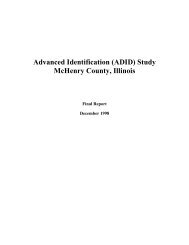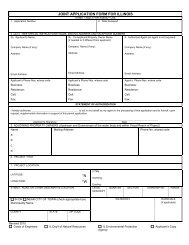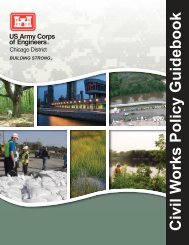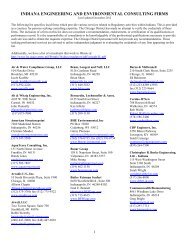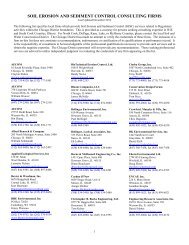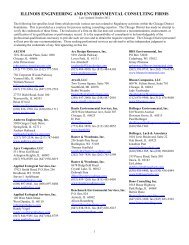Appendix G - Geotechnical Analysis - Chicago District - U.S. Army
Appendix G - Geotechnical Analysis - Chicago District - U.S. Army
Appendix G - Geotechnical Analysis - Chicago District - U.S. Army
You also want an ePaper? Increase the reach of your titles
YUMPU automatically turns print PDFs into web optimized ePapers that Google loves.
equired depth. The depth of the sheet piling will likely depend on the depth of the<br />
permeable sandy layers rather than the required depth for structural stability. Based on this<br />
analysis using DP2-11-11, the floodwall appears stable to construct.<br />
Seepage<br />
57. Floodwall seepage analysis was completed using the results from DP2-11-11. SEEP/W<br />
software was used which determined this site would be minimally susceptible to seepage but<br />
piping may occur in areas where sands are present in the subsurface. To reduce the potential<br />
for piping, the silty sand layers should be cut off with the sheet piling. This is near elevation<br />
592 NAVD88 in DP2-11-11, which equates to a 26-foot long sheet pile. In DP2-11-10, the<br />
sand layer was encountered to about elevation 601 NAVD88, which equates to a 17-foot<br />
sheet pile. Additional soil investigations are required to better map the sandy subsurface<br />
layers that require cutoff to reduce the risk of seepage and piping.<br />
Construction<br />
58. The floodwall may experience difficulty driving piles into the hard clay and extremely<br />
dense silt encountered as shallow as 13 feet below grade or elevation 601. Water was<br />
encountered as shallow as 7 feet below grade. However, since floodwall construction does<br />
not include much excavation, groundwater in not expected to be encountered during<br />
construction.<br />
Additional Information<br />
59. Additional soil investigations should be completed along the alignment of this proposed<br />
floodwall. Generally, 3 soil borings every 1,000 feet is suitable to locate most unsuitable<br />
soils. These borings should be collected on the landside, riverside, and centerline.<br />
Laboratory tests including hydraulic conductivity and compression tests should be completed<br />
to better determine the soil characteristics.<br />
Adler Park Levee (DPLV15) – Plate 7 (removed from consideration)<br />
60. This site encountered clay with a few sand seams/layers. Plan and profile views of the<br />
borings are shown on Plates 7 and 7a. This is consistent with the anticipated conditions as<br />
the adjacent North Libertyville Levee soil borings encountered similar strata. Therefore, like<br />
the North Libertyville Levee, this levee will likely require an inspection trench to cut off<br />
potential shallow seepage paths. The detailed settlement, stability, and seepage analyses are<br />
in Attachment 4.<br />
Settlement<br />
61. The settlement analysis used the conditions presented in DP2-11-01 and calculated it to<br />
be on the order of ¾-foot or less. Soil borings adjacent to the project site did not encounter<br />
any soils that may result in higher anticipated settlements than this estimate.<br />
21<br />
P:\PRJ-Des Plaines II\TS-DG <strong>Geotechnical</strong>\Feasibility <strong>Appendix</strong>\Des Plaines II Geotech <strong>Appendix</strong> 082713.Doc



